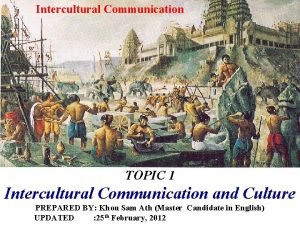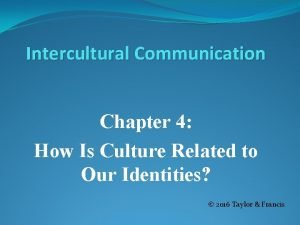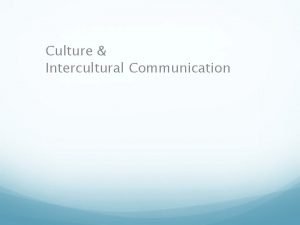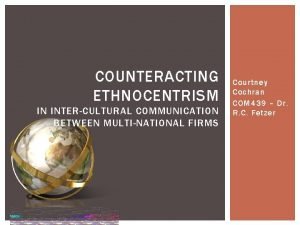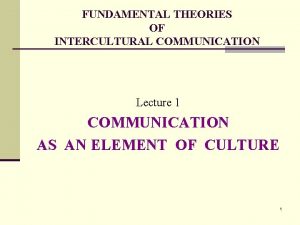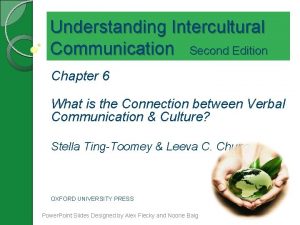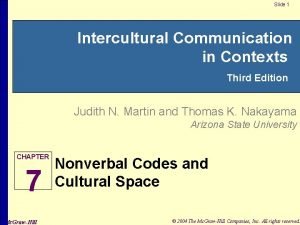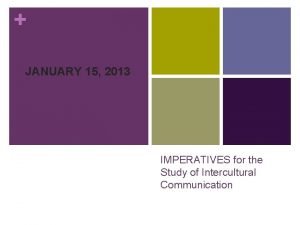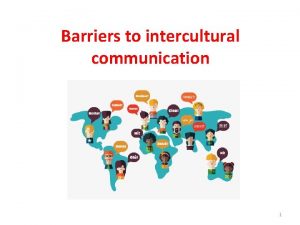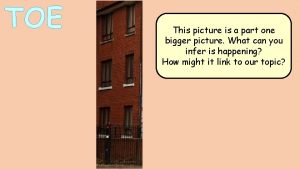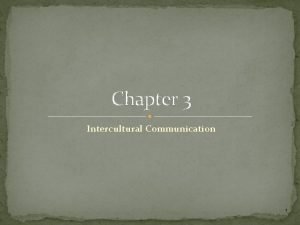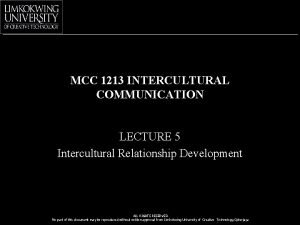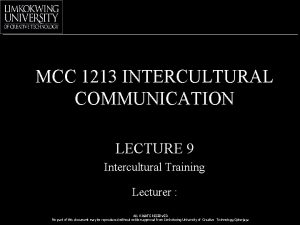INTERCULTURAL COMMUNICATION one of the worlds most significant


























- Slides: 26

INTERCULTURAL COMMUNICATION “…one of the world’s most significant problems: intercultural relations…” Edward T. Hall

OUTLINE OF TODAY’S LECTURE 1. The Nature of Intercultural Communication 2. Dominant Cultural Orientations 3. Domains of Cultural Differences 4. Steps Towards Effective Communication

PART I THE NATURE OF INTERCULTURAL COMMUNICATION

DEFINITION Intercultural communication is: communication between at least two people from different cultures.

WHY STUDY INTERCULTURAL COMMUNICATION? Increasing interaction between people due to globalization Increasing diversity in workplaces Increasing need to develop caring, responsible and ethical business leaders

DEFINITION OF CULTURE What is ‘culture’ in intercultural communication?

FUNDAMENTAL CHARACTERISTICS OF CULTURE Learned Shared Shapes attitudes Prescribes behavior Dynamic Plural

INTERCULTURAL DOMAINS § § § National cultures Social groups Ethnic groups Genders Age or generational groups (and more…)

IMPLICATIONS If intercultural communication is communication between at least two people from different cultures… ◦ ALL communication between people is essentially intercultural. ◦ Different types of cultures shape communication. ◦ Caring, responsible and ethical business leaders must be effective intercultural communicators.

PART II DOMINANT CULTURAL ORIENTATIONS

CULTURAL ORIENTATIONS 1. How contexting affects communication High Context Low Context

CULTURAL ORIENTATIONS 2) How face-saving affects communication

CULTURAL ORIENTATIONS 3) How the individual is viewed in relation to the group Individualist Collectivist

CULTURAL ORIENTATIONS 4) How time is perceived Monochronic Polychronic

CULTURAL ORIENTATIONS 5) How power is distributed Flat Hierarchical

CULTURAL ORIENTATIONS 6) How decisions are made Top-down Through consensus

CULTURAL ORIENTATIONS Reminder: cultural orientations are NOT dichotomies; they are tendencies.

PART III DOMAINS OF CULTURAL DIFFERENCES

DOMAINS: Verbal Choice of words Organization of messages

DOMAINS: Non-verbal Body language Eye contact Laughter Touch Tone, volume and speed Turn-taking and silence

PART IV STEP TOWARDS EFFECTIVE COMMUNICATION

STEPS TOWARDS EFFECTIVE COMMUNICATION Develop a sense of cultural awareness Do not be ethnocentric Listen genuinely when others speak

STEPS TOWARDS EFFECTIVE COMMUNICATION Do not lapse into your own language while in the presence of others who do not speak it Take responsibility for the communication (e. g. , if miscommunication happens, it is not always the other person’s fault) DO NOT STEREOTYPE

CONCLUSION Intercultural communication: Ø respects people as part of a group AND as individuals. Ø is not about interaction between national cultures only.

CONCLUSION Intercultural competence: Ø helps you deliver your messages clearly, appropriately and persuasively. Ø enables you, as a business leader, to contribute to a just and equitable world.

THANK YOU! Q&A
 Worlds together worlds apart 4th edition
Worlds together worlds apart 4th edition Discrimination in intercultural communication
Discrimination in intercultural communication Example of a low context culture
Example of a low context culture Intercultural communication questions
Intercultural communication questions Reactive ascription
Reactive ascription Youtube intercultural communication
Youtube intercultural communication Intercultural communication notes
Intercultural communication notes Staircase model of intercultural communication
Staircase model of intercultural communication Verbal intercultural communication examples
Verbal intercultural communication examples Nonverbal intercultural communication
Nonverbal intercultural communication Intercultural communication conclusion
Intercultural communication conclusion Ethnocentrism intercultural communication
Ethnocentrism intercultural communication Intercultural communication model
Intercultural communication model Technology and intercultural communication
Technology and intercultural communication Theories of intercultural communication
Theories of intercultural communication Strategies for improving intercultural communication
Strategies for improving intercultural communication Understanding intercultural communication 2nd edition
Understanding intercultural communication 2nd edition Intercultural communication in contexts
Intercultural communication in contexts Demographic imperative intercultural communication
Demographic imperative intercultural communication 4 barriers of intercultural communication
4 barriers of intercultural communication Bitwise and
Bitwise and Most significant
Most significant Argyle's communication cycle
Argyle's communication cycle One god one empire one religion
One god one empire one religion One one one little dogs run
One one one little dogs run One king one law one faith
One king one law one faith One empire one god one emperor
One empire one god one emperor


